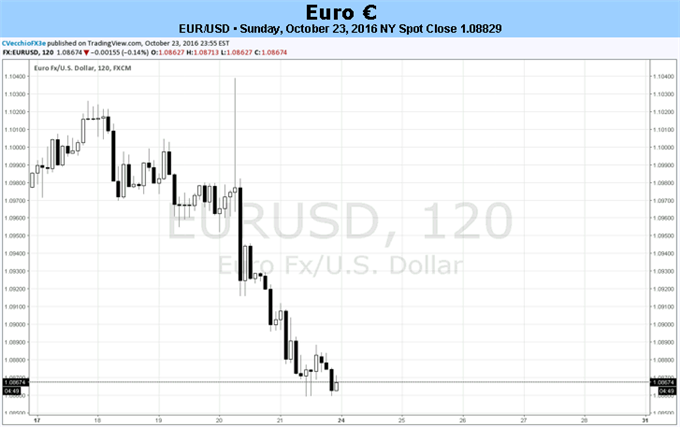
Fundamental Forecast for Euro: Neutral
- ECB President Draghi dispatched speculation of an immediate tapering of QE.
- Traders forced to ‘kick the can’ down the road until December.
- Have a bullish (or bearish) bias on the Euro, but don’t know which pair to use? Use a Euro currency basket.
The Euro took another leg lower this week, sliding deeper in its losing streak as markets were forced to deal with reality: the European Central Bank would not be tapering its QE program immediately. EUR/CAD was the only EUR-cross above water this week (+0.65%), with EUR/JPY (-1.18%) and EUR/NZD (-1.86%) leading the way to the downside as a result.
Mincing no words: it was clear markets were mispricing the ECB rate decision on Thursday. The highly sensitive nature of the Euro to the simple absence of information about the future path of the ECB‘s easing – and then President Draghi’s forceful, ‘we haven’t discussed anything’ approach – is evidence of this mispricing. Either way, what is clear is that Thursday’s ECB meeting was a lesson in ‘Kicking the Can Down the Road 101’: Draghi & co. absolved themselves of any responsibility until the committees tasked with “ensuring the smooth implementation” of the QE programs returns with their notes at the December meeting.
“Ensuring smooth implementation,” in context of the ECB’s desire to maintain its QE program until the medium-term inflation target of +2% is reached, is to prevent collateral scarcity issues from cropping up and perhaps leading to a European ‘taper tantrum.’ Given how far away inflation reality is from the ECB’s target, it would seem that “ensuring smooth implementation” means the ECB is not concerned with upping the size of the QE program.
What will likely happen: at an upcoming meeting, the ECB will indicate that it needs to adjust the way its bond buying program is conducted. The ECB allots its bond buying based on the capital key. What is the capital key? The capital of the ECB comes from the national central banks (NCBs) of all EU member states. According to the ECB, the NCBs’ shares in this capital are calculated using a key which reflects the respective country’s share in the total population and gross domestic product of the EU.
As such, it's no surprise that Germany - as the country with the largest capital key contribution - has seen the belly of its yield curve (3Y-7Y) drift lower into negative territory, below the ECB's -0.40% deposit level - the threshold at which the ECB no longer purchases bonds in its QE program. Likewise, the ECB needs to either: remove the limiting parameter of -0.40% on its bond buying; or discard the capital key variable. In the first case, German yields would like move lower the fastest; in the second, peripheral yields like in Italy and in Spain.
Further, when these changes to the QE program are made, it is likely that an extension of the program is announced, perhaps with some tapering built in. For example, markets had been pricing the QE program to run through the end of March 2017 (roughly €400 billion in asset purchases remaining), but a six month extension even at a slower pace of purchases (say, to €55 billion per month for three month and €20 billion per month for three months) would still amount to a significant increase in easing (roughly an additional €225 billion in asset purchases) above prior expectations. –CV
To receive reports from this analyst, sign up for Christopher’s distribution list.





